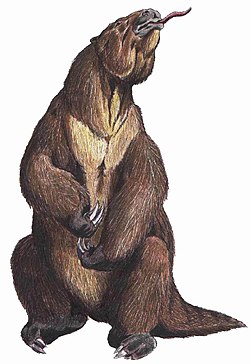| Megalonychidae Temporal range: Early Oligocene-Early Holocene (Hemphillian-Rancholabrean) (NALMA) & Tinguirirican-Lujanian (SALMA) | |
|---|---|
 | |
| Megalonyx wheatleyi skeleton and restoration | |
| Scientific classification | |
| Domain: | Eukaryota |
| Kingdom: | Animalia |
| Phylum: | Chordata |
| Class: | Mammalia |
| Order: | Pilosa |
| Superfamily: | Megatherioidea |
| Family: | † Megalonychidae Gervais, 1855 |
| Type genus | |
| †Megalonyx Jefferson, 1799 | |
| Subgroups | |
See text | |
Megalonychidae is an extinct family of sloths including the extinct Megalonyx . [1] Megalonychids first appeared in the early Oligocene, about 35 million years (Ma) ago, in southern Argentina (Patagonia). [2] There is, however, one possible find dating to the Eocene, about 40 Ma ago, on Seymour Island in Antarctica (which was then still connected to South America). [3] They first reached North America by island-hopping across the Central American Seaway, about 9 million years ago, [4] prior to formation of the Isthmus of Panama about 2.7 million years ago (which led to the main pulse of the Great American Interchange). Some megalonychid lineages increased in size as time passed. The first species of these were small and may have been partly tree-dwelling, whereas the Pliocene (about 5 to 2 million years ago) species were already approximately half the size of the huge Late Pleistocene Megalonyx jeffersonii from the last ice age. [5]
Contents
It was formerly believed, based on morphological comparisons, that Greater Antilles sloths and extant arboreal two-toed sloths were part of this family. However, molecular results based on sequences from collagen [6] and mitochondrial DNA [7] have shown that the former represent a basal branch of the sloth radiation, while the latter are more closely related to mylodontid sloths. The megalonychids plus nothrotheriid and megatheriid sloths, together with living three-toed sloths, make up the sloth superfamily Megatherioidea. [6] [7]
Megalonychidae, along with all other mainland ground sloths became extinct in North and South America around the end of the Late Pleistocene, approximately 12,000 years ago, as part of the Quaternary extinction event following the arrival of humans to the Americas. [8]


